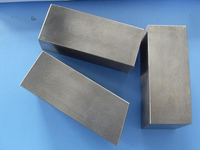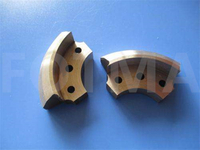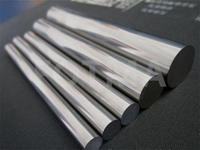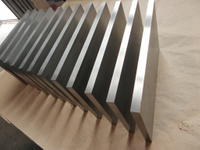Views: 6 Author: Site Editor Publish Time: 2015-06-16 Origin: TungstenChina
Tungsten carbide, WC, or tungsten semi-carbide, W2C, is a chemical compound containing tungsten and carbon, similar to titanium carbide. Colloquially, tungsten carbide is often simply called carbide.
Properties:
Strength - Tungsten carbide has very high strength for a material so hard and rigid. Compressive strength is higher than virtually all melted and cast or forged metals and alloys.
Rigidity - Tungsten carbide compositions range from two to three times as rigid as steel and four to six times as rigid as cast iron and brass. Young's Modulus is up to 94,800,000 psi.
High resistance to deformation and deflection is very valuable in those many applications where a combination of minimum deflection and good ultimate strength merits first consideration. These include spindles for precision grinding and rolls for strip or sheet metal.
Impact Resistant - For such a hard material with very high rigidity, the impact resistance is high. It is in the range of hardened tool steels of lower hardness and compressive strength.
Heat and oxidation resistance - Tungsten-base carbides perform well up to about 1000°F in oxidizing atmospheres and to 1500°F in non-oxidizing atmospheres
Low temperature resistance (cryogenic properties) - Tungsten carbide retains toughness and impact strength in the cryogenic temperature ranges. (-453°F.)
Thermal Conductivity - Tungsten carbide is in the range of twice that of tool steel and carbon steel.
Electrical Conductivity - Tungsten carbide is in the same range as tool steel and carbon steel.
Specified Heat - Tungsten carbide ranges from about 50% to 70% as high as carbon steel.
Weight - The specific gravity of tungsten carbide is from 1-1/2 to 2 times that of carbon steel.
Hot Hardness - With temperature increase to 1400°F, tungsten carbide retains much of its room temperature hardness. At 1400°F, some grades equal the hardness of steels at room temperature.
Tolerances - Many surfaces of even complete parts can be used the way they come from the furnace, "as sintered", such as mining or drilling compacts. In those parts requiring precision ground accuracy, such as stamping dies, close-tolerance performs are provided for grinding or EDM.
Methods of Fastening - Tungsten carbide can be fastened to other materials by any of three methods; brazing, epoxy cementing, or mechanical means. Tungsten carbide's low thermal expansion rate must be carefully considered when performs are provided for grinding or EDM.
Coefficient of Friction - Tungsten carbide compositions exhibit low dry coefficient of friction values as compared to steels.
Galling - Tungsten carbide compositions have exceptional resistance to galling and welding at the surface.
Corrosion-Wear Resistance - Specific grades are available with corrosion resistance approaching that of noble metals. Conventional grades have sufficient resistance to corrosion-wear conditions for many applications.
Wear-Resistance - Tungsten carbide wears up to 100 times longer than steel in conditions including abrasion, erosion and galling. Wear resistance of tungsten carbide is better than that of wear-resistance tool steels.
Surface Finishes - Finish of an as-sintered part will be about 50 micro inches. Surface, cylindrical, or internal grinding with diamond wheel will produce 18 micro inches or better and can produce as low as 4 to 8 micro inches. Diamond lapping and honing can produce 2 micro inches and with polishing as low as 1/2 micro inch.
Dimensional Stability - Tungsten carbide undergoes no phase changes during heating and cooling and retains its stability indefinitely. No heat treating is required.
Structure
There are two forms of WC, a hexagonal form, α-WC, and a cubic high temperature form, β-WC, which has the rock salt structure. The hexagonal form can be visualized as made up of hexagonally close packed layers of metal atoms with layers lying directly over one another, with carbon atoms filling half the interstices giving both tungsten and carbon a regular trigonal prismatic, 6 coordination. From the unit cell dimensions the following bond lengths can be determined; the distance between the tungsten atoms in an hexagonally packed layer is 291 pm, the shortest distance between tungsten atoms in adjoining layers is 284 pm, and the tungsten carbon bond length is 220 pm. The tungsten-carbon bond length is therefore comparable to the single bond in W(CH3)6 (218pm) in which there is strongly distorted trigonal prismatic coordination of tungsten.
Molecular WC has been investigated and this gas phase species has a bond length of 171 pm for 184W12C.
Applications
Machine tools
Carbide cutting surfaces are often useful when machining through materials such as carbon steel or stainless steel, as well as in situations where other tools would wear away, such as high-quantity production runs. Most of the time, carbide will leave a better finish on the part, and allow faster machining. Carbide tools can also withstand higher temperatures than standard high speed steel tools. The material is usually called cemented carbide, hardmetal or tungsten-carbide cobalt: it is a metal matrix composite where tungsten carbide particles are the aggregate and metallic cobalt serves as the matrix.
Military
Tungsten carbide is often used in armor-piercing ammunition, especially where depleted uranium is not available or not politically acceptable. The first use of W2C projectiles occurred in German Luftwaffe tank-hunter squadrons, which used 37 mm autocannon equipped Junkers Ju 87G dive bomber aircraft to destroy Soviet T-34 tanks in World War II. Owing to the limited German reserves of tungsten, W2C material was reserved for making machine tools and small numbers of projectiles for the most elite combat pilots, like Hans Rudel. It is an effective penetrator due to its high hardness value combined with a very high density.
Tungsten carbide ammunition can be of the sabot type (a large arrow surrounded by a discarding push cylinder) or a subcaliber ammunition, where copper or other relatively soft material is used to encase the hard penetrating core, the two parts being separated only on impact. The latter is more common in small-caliber arms, while sabots are usually reserved for artillery use.
Tungsten carbide is also an effective neutron reflector and as such was used during early investigations into nuclear chain reactions, particularly for weapons. A criticality accident occurred at Los Alamos National Laboratory on 21 August 1945 when Harry K. Daghlian, Jr. accidentally dropped a tungsten carbide brick onto a plutonium sphere, causing the sub-critical mass to go critical with the reflected neutrons.
Sports
Hard carbides, especially tungsten carbide, are used by athletes, generally on poles which impact hard surfaces. Trekking poles, used by many hikers for balance and to reduce pressure on leg joints, generally use carbide tips in order to gain traction when placed on hard surfaces (like rock); such carbide tips last much longer than other types of tips.
While ski pole tips are generally not made of carbide, since they do not need to be especially hard even to break through layers of ice, rollerski tips usually are. Roller skiing emulates cross country skiing and is used by many skiers to train during warm weather months.
Sharpened carbide tipped spikes (known as studs) can be inserted into the drive tracks of snowmobiles. These studs enhance traction on icy surfaces. Longer v-shaped segments fit into grooved rods called wear rods under each snowmobile ski. The relatively sharp carbide edges enhance steering on harder icy surfaces. The carbide tips and segments reduce wear encountered when the snowmobile must cross roads and other abrasive surfaces.
Some tire manufacturers, such as Nokian and Schwalbe, offer bicycle tires with tungsten carbide studs for better traction on ice. These are generally preferred over steel studs because of their wear resistance.
Domestic
Tungsten carbide is used as the rotating ball in the tips of ballpoint pens to disperse ink during writing.
Tungsten carbide steel is used in most razors.
Tungsten carbide can now be found in the inventory of some jewelers, most notably as the primary material in men's wedding bands. When used in this application the bands appear with a lustrous dark hue often buffed to a mirror finish. The color is more similar to that of hematite than to that of platinum. The finish is highly resistant to scratches and scuffs, holding its mirror-like shine for years.
A common misconception held concerning tungsten carbide rings is they cannot be removed in the course of emergency medical treatment, requiring the finger to be removed instead. Emergency rooms and many full-service jewelry repair shops are equipped with jewelers' saws that can cut through gold, silver, platinum, titanium, and tungsten carbide rings without injuring the patient when the ring cannot be slipped off easily. Tungsten carbide rings can also be removed in an emergency situation by cracking them into pieces with standard vice grip–style locking pliers.
Many manufacturers of this emerging jewelry material state that the use of a cobalt binder may cause unwanted reactions between the cobalt and the natural oils on human skin. Skin oils cause the cobalt to leach from the material. This is said to cause possible irritation of the skin and permanent staining of the jewelry itself. Many manufacturers now advertise that their jewelry is "cobalt free". This is achieved by replacing the cobalt with nickel as a binder.
content is empty!





